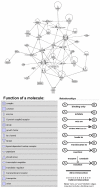Identification of homogeneous genetic architecture of multiple genetically correlated traits by block clustering of genome-wide associations
- PMID: 21611967
- PMCID: PMC3312758
- DOI: 10.1002/jbmr.333
Identification of homogeneous genetic architecture of multiple genetically correlated traits by block clustering of genome-wide associations
Abstract
Genome-wide association studies (GWAS) using high-density genotyping platforms offer an unbiased strategy to identify new candidate genes for osteoporosis. It is imperative to be able to clearly distinguish signal from noise by focusing on the best phenotype in a genetic study. We performed GWAS of multiple phenotypes associated with fractures [bone mineral density (BMD), bone quantitative ultrasound (QUS), bone geometry, and muscle mass] with approximately 433,000 single-nucleotide polymorphisms (SNPs) and created a database of resulting associations. We performed analysis of GWAS data from 23 phenotypes by a novel modification of a block clustering algorithm followed by gene-set enrichment analysis. A data matrix of standardized regression coefficients was partitioned along both axes--SNPs and phenotypes. Each partition represents a distinct cluster of SNPs that have similar effects over a particular set of phenotypes. Application of this method to our data shows several SNP-phenotype connections. We found a strong cluster of association coefficients of high magnitude for 10 traits (BMD at several skeletal sites, ultrasound measures, cross-sectional bone area, and section modulus of femoral neck and shaft). These clustered traits were highly genetically correlated. Gene-set enrichment analyses indicated the augmentation of genes that cluster with the 10 osteoporosis-related traits in pathways such as aldosterone signaling in epithelial cells, role of osteoblasts, osteoclasts, and chondrocytes in rheumatoid arthritis, and Parkinson signaling. In addition to several known candidate genes, we also identified PRKCH and SCNN1B as potential candidate genes for multiple bone traits. In conclusion, our mining of GWAS results revealed the similarity of association results between bone strength phenotypes that may be attributed to pleiotropic effects of genes. This knowledge may prove helpful in identifying novel genes and pathways that underlie several correlated phenotypes, as well as in deciphering genetic and phenotypic modularity underlying osteoporosis risk.
Copyright © 2011 American Society for Bone and Mineral Research.
Figures


References
Publication types
MeSH terms
Grants and funding
LinkOut - more resources
Full Text Sources
Medical

